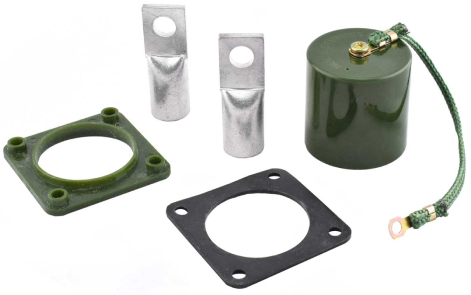Military tested and proven in the field, Amerline's NATO accessories are products you can depend on. This list of accessories includes NATO slave cables, plugs, receptacles, adapters, and terminals. From an application standpoint, the NATO field plug will work on all tactical wheeled vehicles.
Environmentally Sealed Connectors
Environmentally sealed is a pivotal product design feature that supports durability and protection. From aerospace and automotive to marine and industrial manufacturing, the importance of these specialized seals and barriers echoes across various industries.
What Is Environmentally Sealed?
The term "environmentally sealed" refers to products designed with protective measures to shield them from harsh environmental conditions. Environmentally sealed connectors and products are equipped with seals or barriers that withstand high pressures, moisture, extreme temperature, chemicals and dust. By effectively blocking out these elements, environmental seals ensure durability and reliability in harsh environments.
How Does Environmental Sealing Work?
Environmentally sealed electrical components and products use specialized materials like rubber seals that offer superior resistance to various environmental factors. These seals are strategically positioned to cover vulnerable areas of products, such as electrical contacts or sensitive components.
Materials Used in Environmental Sealing
Rubber, including synthetic rubber compounds, is often used based on its resilience, flexibility and resistance to moisture and chemicals. Silicone offers similar advantages, with the added benefit of temperature resistance. With their exceptional durability and chemical resistance, advanced polymers are also suitable for demanding environments.
Sealing Techniques & Technologies
A number of sealing methods and technologies are used to achieve environmental protection. The choice depends on both the application’s requirements as well as the characteristics of the materials involved.
Physical seals, like gaskets and O-rings, create a barrier between components to prevent the ingress of moisture, dust and other contaminants. Chemical coatings, such as potting compounds, are applied to surfaces to add a protective layer against external factors.
Applications of Environmental Sealing
Protection Against Moisture
Moisture, whether in the form of high humidity, rain or snow, can pose significant challenges to various industrial applications. Environmentally sealed products serve as a barrier against moisture ingress, safeguarding sensitive components and preserving their functionality. They are crucial in outdoor systems like security cameras and industrial equipment, ensuring uninterrupted operation in adverse weather conditions.
Protection Against Chemicals
In industrial settings, exposure to chemicals is inevitable, posing a threat to the integrity of equipment and components. Environmentally sealed products, fortified with synthetic rubber seals that are resistant to oils, gases and other chemicals, offer reliable protection against corrosion and degradation. By maintaining their structural integrity in the presence of chemicals, these products reduce downtime and maintenance costs.
Protection Against Dust
Dust accumulation is a common challenge in industrial processes that can cause damage and performance degradation in equipment and components. Environmentally sealed products prevent dust ingress, preserving the cleanliness and functionality of sensitive components. By mitigating the risk of poor contact and corrosion, these products enhance the longevity and reliability of industrial systems.
FAQs on Environmentally Sealed
What industries most commonly require environmentally sealed components?
Industries that operate in a harsh environment often require environmentally sealed components to ensure the reliability and longevity of their equipment. Common sectors include aerospace, automotive, marine, industrial manufacturing, oil and gas, renewable energy, and outdoor electronics.
How does environmental sealing affect the weight and size of a product?
Environmental sealing can impact the weight and size of a product depending on the sealing method and materials used. Some sealing techniques add minimal weight and size; others can have more of an impact. Manufacturers can help balance these needs.
Are environmentally sealed products environmentally friendly?
The environmental friendliness of environmentally sealed products depends on various factors, including the materials used in their construction and their end-of-life disposal. Manufacturers strive to use materials that minimize environmental impact and adhere to regulations regarding waste management and recycling practices.
How does environmental sealing relate to and differ from hermetic sealing?
Environmental and hermetic sealing are two methods used to protect components or products from external factors. However, they differ in their sealing objectives and degree of protection. Whereas an environmental seal safeguards against common hazards like moisture and dust while allowing for some air exchange, a hermetic seal creates an impermeable barrier against the ingress of gases. Hermetic seals are often achieved through welding and soldering.
What are some challenges of designing environmental and hermetic connectors?
When designing environmental connectors and hermetic connectors, some of the common challenges include balancing sealing effectiveness with product functionality, ensuring compatibility between sealing materials and components, and addressing potential points of failure such as thermal expansion and mechanical stresses.
How do regulatory standards influence the design of environmentally sealed products?
Regulatory standards play a significant role in shaping the design and manufacturing processes of environmentally sealed products. Standards such as IP (Ingress Protection) ratings specify the level of protection provided against moisture, dust and other contaminants, guiding manufacturers in selecting appropriate sealing methods and materials. Compliance with industry-specific regulations ensures product safety, reliability and market acceptance.
What innovations are emerging in the field of environmental sealing?
Innovations in environmental sealing focus on enhancing sealing effectiveness, durability and efficiency while minimizing weight and size. Material science advancements have supported the development of materials with improved properties, while additive manufacturing advancements have driven greater precision and allowed for more customization in sealing applications.
Looking for high-quality, dependable connectors?
Interchangeable with military-style connectors, Amerline’s AEC connectors are built to withstand severe environments, power demands and size constraints. We offer overmolding services for this line of connectors, delivering the added protection you need without the headaches.


